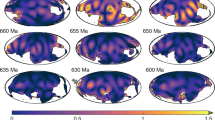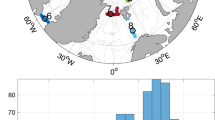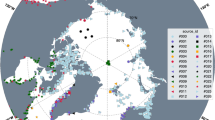Abstract
Roden and Groves1 wrote: “The oceanographic aspects of the Gulf of California, one of the least known marginal seas of the North Pacific, are both interesting and complex”. Tidal processes certainly justify the statement. With a reported spring range of 10 m as well as currents exceeding 6 knots (ref. 2) the tides in the Gulf of California are among the most spectacular and dangerous in the world. Nevertheless, because of the rarity and inadequacy of observations, no consistent picture could be drawn until recently. Many quantitative studies of this area must thus be regarded as provisional; there is, for example, an eight-fold range in estimates of energy dissipation for the semidiurnal lunar tide, namely, Heiskanen3,4: 2.5×1017 erg s−1; Miller5: 4×1017 erg s−1; Hendershott6: 1 to 2×1017 erg s−1; and my proposed values: 4.35×1016 erg s−1 for M2 alone, 4.65×1016 erg s−1 for all semidiurnal lunar constituents and 4.85×1016 erg s−1 for all lunar constituents.
This is a preview of subscription content, access via your institution
Access options
Subscribe to this journal
Receive 51 print issues and online access
$199.00 per year
only $3.90 per issue
Buy this article
- Purchase on Springer Link
- Instant access to full article PDF
Prices may be subject to local taxes which are calculated during checkout
Similar content being viewed by others
References
Roden, G. I., and Groves, G. W., J. Mar. Res., 18, 10 (1959).
US Hydrographic Office Publication, HO26, 64 (1951).
Heiskanen, W., Amer. Acad. Sci. Fernicae, A, 18, 1 (1921).
Munk, W., Quart. J. Roy. Astron. Soc., 9, 352 (1968).
Miller, G. R., J. Geophys. Res., 71, 2485 (1966).
Hendershott, M. C., and Speranza, A., Deep-Sea Res., 18, 959 (1971).
Filloux, J. H., Science, 169, 862 (1970).
Fisher, R. L., Rusnak, G. A., and Shepard, F. P., Bathymetric Chart of the Gulf of California (Scripps Institute of Oceanography, University of California, 1964).
Garrett, C. J. R., and Munk, W. H., Deep-Sea Res., 18, 493 (1971).
Filloux, J. H., Proc. Workshop Electromag. Ind. Edinburgh, 1972, Phys. Earth Planet. Int. (in the press).
Munk, W. H., and MacDonald, G. J. F., The Rotation of the Earth (Cambridge Univ. Press, 1960).
Jeffreys, H., Phil. Trans. Roy. Soc., A, 221, 239 (1920).
Cox, C. S., and Sandstrom, H., J. Ocean. Soc. Jap., Twentieth Anniv. Vol., 499 (1962).
Author information
Authors and Affiliations
Rights and permissions
About this article
Cite this article
FILLOUX, J. Tidal Patterns and Energy Balance in the Gulf of California. Nature 243, 217–221 (1973). https://doi.org/10.1038/243217a0
Received:
Revised:
Issue Date:
DOI: https://doi.org/10.1038/243217a0
This article is cited by
-
Eutrophication assessment and environmental management perspectives of Tóbari: an arid subtropical coastal lagoon of the Gulf of California
Environmental Monitoring and Assessment (2023)
-
A comparative analysis of harvested and unharvested populations of the smooth Venus clam Chionista fluctifraga in the Gulf of California
Fisheries Science (2022)
-
Semidiurnal amphidrome of the North East Pacific: Where?
Marine Geophysical Researches (1984)
-
Tidal energy balance in the Seto Inland Sea
Journal of the Oceanographical Society of Japan (1982)
-
Gravitational driving and energy of Adriatic tides
Nature (1974)
Comments
By submitting a comment you agree to abide by our Terms and Community Guidelines. If you find something abusive or that does not comply with our terms or guidelines please flag it as inappropriate.



